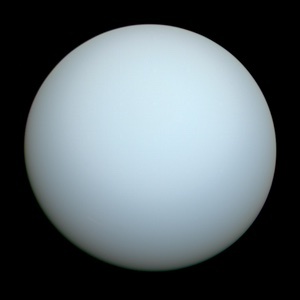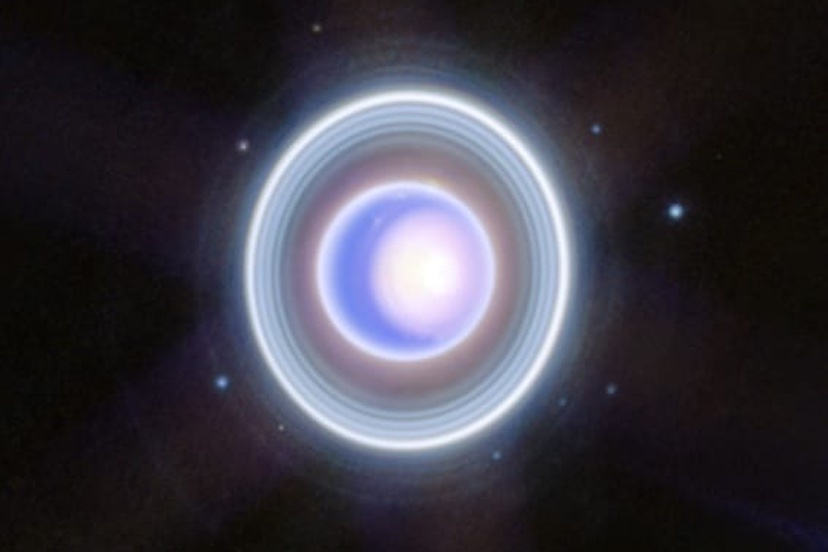Digital image of Uranus generated by the James Webb Space Telescope, showing some of its 13 rings and a few of its 28 moons. Not its true colors.
The jokes pretty much write themselves, when scientists talk about probing Uranus.
But it’s no joke that certain NASA scientists have decided that “the highest priority flagship mission… should be a probe of Uranus,” according to a recent report by Isaac Schultz on Gizmondo.com
NASA is hoping the European Space Agency will participate. The more the merrier, when you’re probing Uranus, apparently.
Sort of a ménage à trois?
For thousands of years, humans had no idea that Uranus even existed. A Greek named Hipparchus may have noticed it in 128 BC and included it on his star chart, thinking it was just another star. But then again, maybe he didn’t, and history scholars are mistaking a flyspeck for Uranus.
Uranus is definitely not a flyspeck. (See the image above, from the Webb Space Telescope.)
The astronomer Sir William Herschel noticed what he thought was a “Nebulous star” on March 13, 1781, in the constellation Taurus, but on March 17, he noticed it had moved slightly, and he concluded it was a ‘comet’. Other astronomers subsequently concluded (correctly) that it was not a comet, but rather, a hitherto-unknown planet beyond the orbit of Saturn.
Nevertheless, Sir Herschel was granted a stipend of $30,000 a year by King George III on the condition that he move to Windsor so that the Royal Family could look through his telescopes. (This is indeed the same King George III responsible for starting a war against unruly American colonists, a few years earlier. No doubt the telescopes were a welcome distraction.)
Once Uranus was discovered, it pretty much got ignored, which is understandable, considering it’s more than 1.6 billion miles away. (That’s billion with a “b”.). Also, it’s boring to look at. Here’s a closeup photo taken by the Voyager 2 spaceship in 1986, showing the planet’s actual color.

About as interesting as a ping pong ball.
We note that the 13 rings (which are actually very dark) do not appear in this photo. In reality, the rings are also kind of boring.
After the NASA scientists saw the photo of Uranus, I imagine they said to themselves, “Well, no sense trying to learn more about that planet. It’s about an interesting as a ping pong ball.”
Also, it takes 13 years for a space probe to get from Earth to Uranus. You could probe a lot of other planets and moons, in 13 years.
But suddenly, this year, it’s the “the highest priority flagship mission” over the next couple of decades. Can anyone explain government bureaucracy to me?
From an article by Olivier Mousis and Robin Canup in Nature magazine, May 20, 2024:
This week, space and planetary scientists are meeting at the Goddard Space Flight Center in Greenbelt, Maryland, to scope out a new flagship NASA mission — the Uranus Orbiter and Probe. Still on the drawing board, the project would entail sending a spacecraft to orbit Uranus and drop a probe into the planet’s atmosphere. The spacecraft, which could be built and launched within a decade, would investigate the nature of Uranus, including its unusual tilt and magnetic field. It would also search the planet’s moons for signs of hidden oceans and other potentially habitable environments.
“Habitable” in what sense of the word? The article didn’t say. But the scientists at NASA are fascinated by the “exotic chemistry” exhibited by Uranus. They call it an “ice giant” because — unlike Jupiter and Saturn, which are “gas giants” — it seems to be mostly ice. (Again, I ask about the meaning of “habitable”.)
Ice giants are also the most common type of exoplanet in the Milky Way. With characteristics that lie between those of gas giants and of Earth and other terrestrial planets, it’s crucial to learn how such systems formed and evolved.
Like… “crucial” to whom?
It’s “crucial” to know how long that uncooked chicken breast has been in my refrigerator. That’s “crucial”.
Knowing how Uranus formed and evolved is absolutely not “crucial”.
So many other, more important things need to be probed.
Underrated writer Louis Cannon grew up in the vast American West, although his ex-wife, given the slightest opportunity, will deny that he ever grew up at all. You can read more stories on his Substack account.

